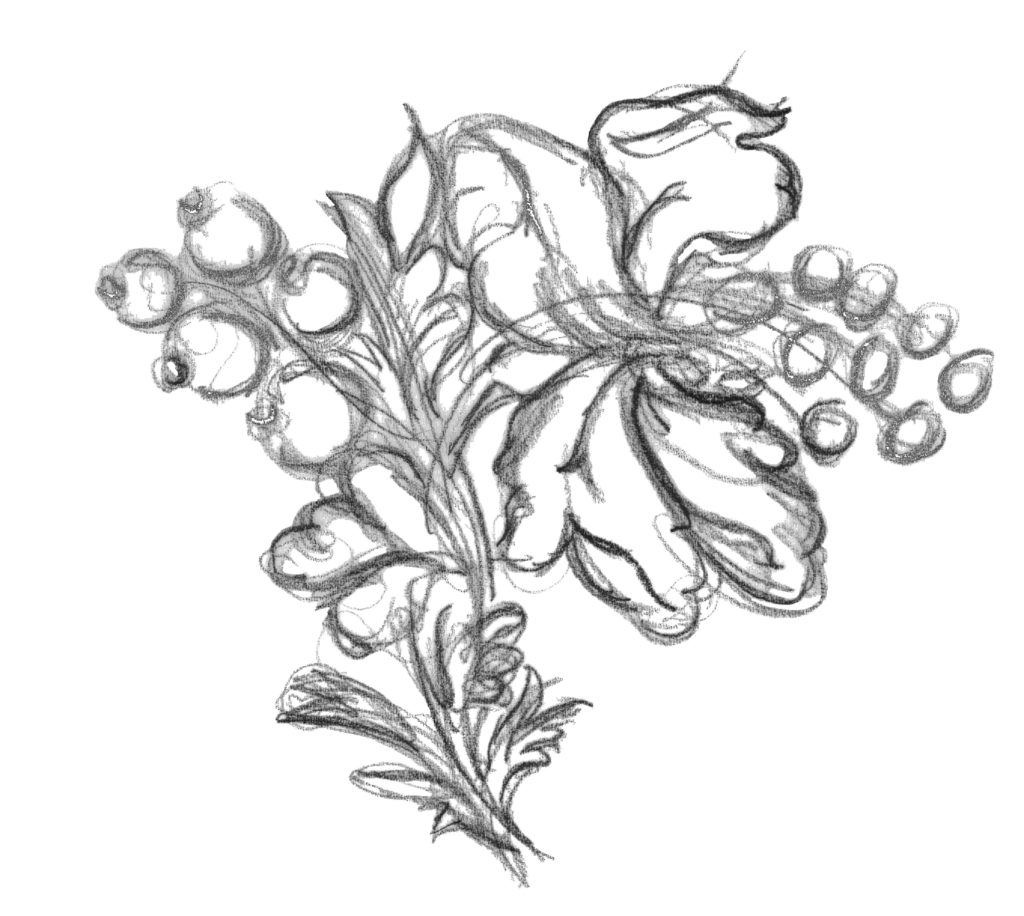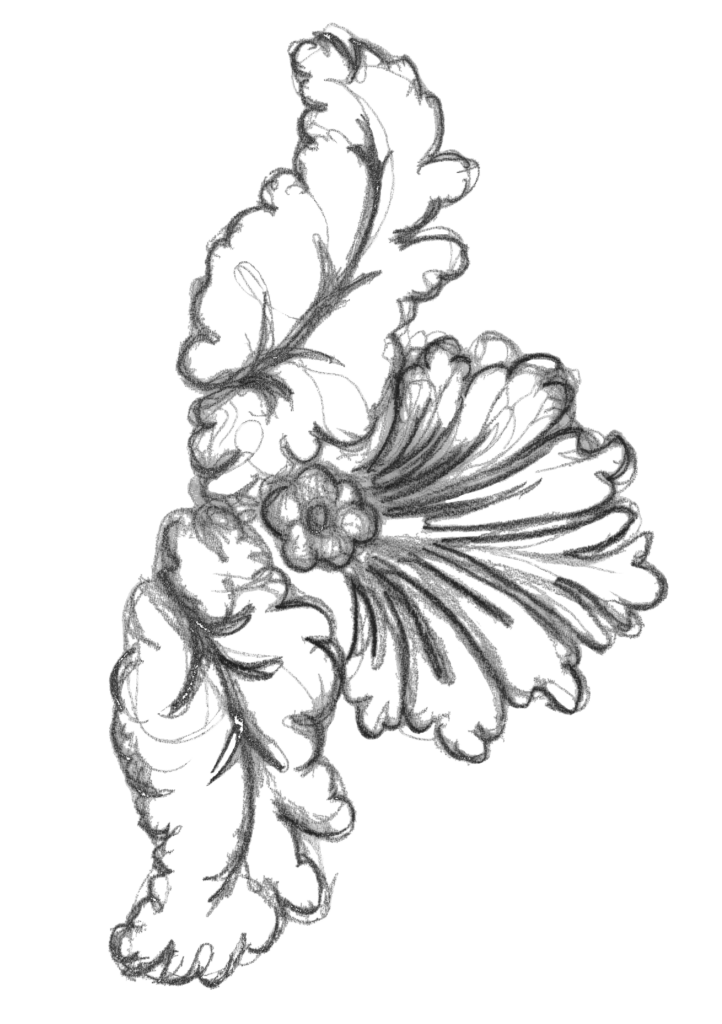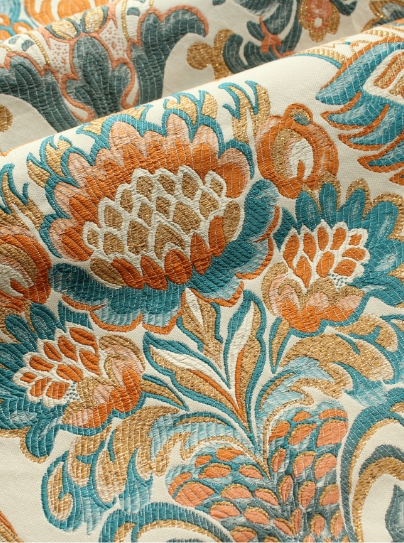The first of our Humphries Weaving series of historic periods, written by Charlotte Bainbridge.
In this series, the Humphries Weaving team, will aim to explore key styles through the lens of interiors, textiles, designs and key figures. Our aim is to discuss different historical periods to inform our historical and contemporary projects, whether through direct inspiration or what we like to describe as a decoupage or homage to the period.
Early Gothic
Early Gothic first appeared in the early 12th century in France. Ironically, the term “Gothic” was first used by Italian writers in the 15th–17th century as an insult. Giorgio Vasari, the 16th-century art historian, was one of the first known writers to label this style, claiming “barbarous nations erected buildings in that style which we call Gothic” (The Met Museum). According to the V&A, “they denounced this type of art as unrefined and ugly and attributed it to the Gothic tribes which destroyed the Roman Empire and its classical culture.”
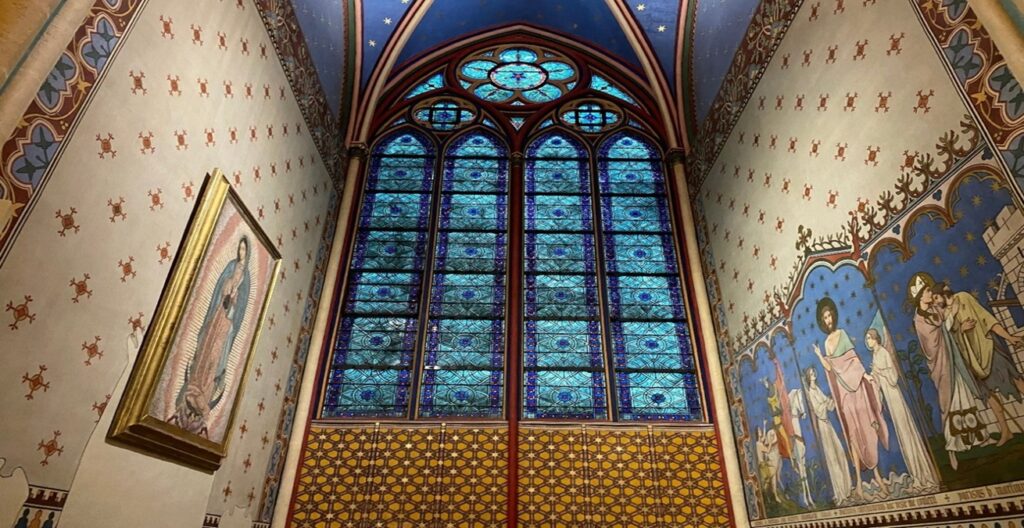
Early Gothic Architecture:
With beginnings in France, the Gothic style started with the building of cathedrals, and it was the revolutionary architectural techniques that made the style’s defining features possible. Architects developed methods to build structures of new heights, demonstrating both power and spiritual aspiration. Cathedrals such as Notre Dame, Canterbury Cathedral, and Westminster Abbey were designed to be visible from miles away, their spires piercing the skyline.
Key Architectural Features:
Pointed Arches and Ribbed Vaulting, unlike the rounded Romanesque arches that preceded them, Gothic pointed arches distributed weight more efficiently, allowing for greater height. The ceiling vaults are divided by stone ribs that create a web-like structure, giving viewers the impression of soaring, almost infinite height. These ribs drew the eye upward, reinforcing the spiritual journey toward heaven.
Flying Buttresses: Beginning in the fourth quarter of the 12th century, flying buttresses became the signature external support system of Gothic architecture. These arched exterior supports transferred the outward thrust of the roof away from the walls, allowing builders to create thinner walls and larger window openings. The buttresses themselves became decorative elements, often adorned with pinnacles and carved details.
Stained Glass and Light:
With walls no longer bearing the full structural load, Gothic architects could pierce them with vast windows. Stained glass became one of the most distinctive features of Gothic architecture. These windows were filled with intensely coloured glass depicting biblical scenes, saints, and intricate geometric patterns. Large circular windows with radiating tracery became centrepieces of cathedral facades. Lancet windows, tall and narrow with pointed tops, lined the nave. The designs evolved from simple geometric patterns to elaborate flowing designs featuring trefoils (three-lobed shapes), quatrefoils (four-lobed), and cinquefoils (five-lobed).
Natural Motifs:
Churches took particular inspiration from the natural world, especially leaf forms. Columns were carved with realistic foliage depicting oak leaves, ivy, and vine tendrils. This was a departure from the stylised acanthus leaves of classical architecture.
Gothic Textiles:
The relationship between Gothic style and textiles is profound, particularly within ecclesiastical settings. During this period, the Church was the primary patron of fine textiles, along with the monarchy. Few others possessed the wealth or status to commission such luxurious woven goods.
Ecclesiastical Textiles:
Gothic ecclesiastical textiles were among the most magnificent woven fabrics, silk damasks, velvets, and brocades that adorned altars, draped over clergy, and hung as ceremonial banners. In the schemes of copes, dalmatics, and altar frontals.
With heraldic and Symbolic Motifs:
Repeated patterns of crosses, fleur-de-lis, eagles, and lions. These symbols conveyed religious significance and institutional identity.
Gothic textiles often drew directly from architecture, translating stone tracery into woven form. Pointed arches, ogee curves, and Gothic quatrefoils appeared in damask patterns. Diaper patterns, small repeated geometric designs forming an overall lattice, echoed the regularity of ribbed vaulting.
Damasks featured reversible patterns created by contrasting satin and sateen weaves, creating subtle tone-on-tone effects. Lampas weaves combined a foundation cloth with supplementary wefts, creating raised patterns. Brocades incorporated metallic threads woven as supplementary elements. These technically demanding weaves required drawlooms and highly skilled weavers.
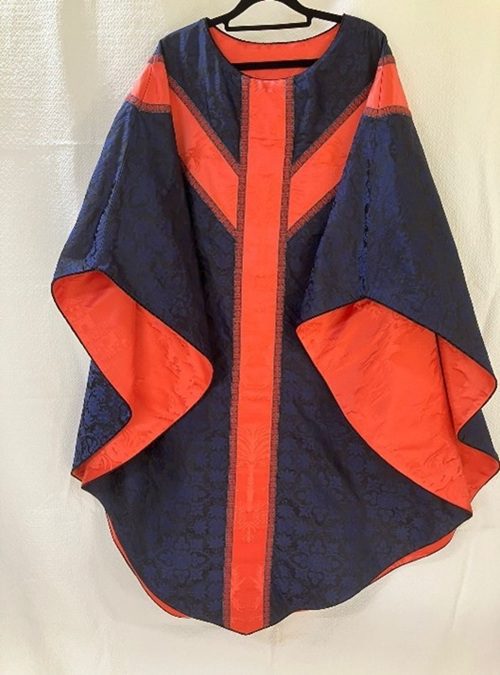
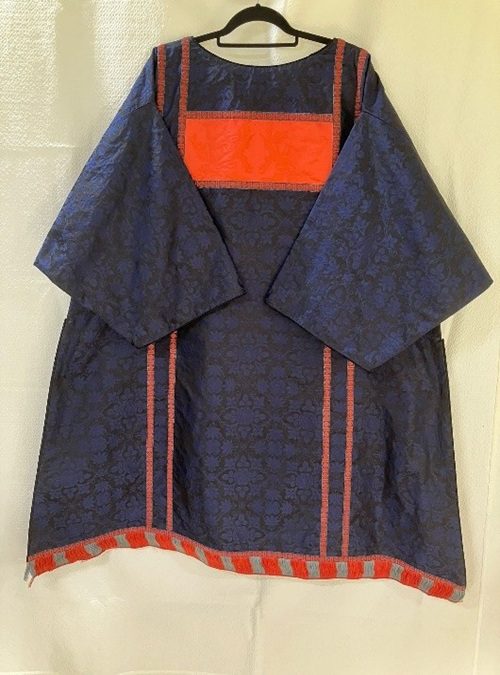
Humphries Weaving & Gothic Revival:
The interiors and furnishings of this style were revived during two periods: 1750–1770 and again in 1800–1875. Great houses such as Horace Walpole’s Strawberry Hill in London epitomised 18th-century Gothic form and style.
The 19th century saw revival styles ranging from Greek through to Neoclassical, all revisited and reinterpreted for contemporary tastes. Gothic Revival became closely associated with ecclesiastical renewal. See our previous article on Historic Textiles for the Metropolitan Museum of New York. The Gothic Library designed by Frederick Clark Withers features curtains featuring our Pentlow Damask and Border fabrics in silk and wool here
Key Influences:
- Horace Walpole at Strawberry Hill House
- Augustus Welby Northmore Pugin
- The Houses of Parliament restoration
- The Palace of Westminster
The current Palace of Westminster was designed by the architect Sir Charles Barry after an earlier building was ravaged by fire in 1834. However, it was Pugin who designed the interior details, furnishings, and decorative schemes that gave the building its distinctive Gothic Revival character.
The Speaker’s State Bed is situated in the State Bedroom and was originally intended for the monarch to sleep in on the night before the Coronation.
Humphries Weaving created a silk and linen brocatelle in geranium and gold, and also a plain geranium lustring, both used for hangings on the State Bed and upholstery for two prie-dieus. A sample of the geranium lustring is also in the Victoria & Albert Museum, London, textile collection.
The Cavendish Damask is a Pugin design which was redrawn by the Humphries Weaving team. The original design was woven on a loom which had to be specially built to accommodate the scale of the design, a testament to Pugin’s ambitious vision and attention to Gothic proportion.
Project references: 563 / 517
Auckland Castle: Restoring Gothic Splendour
Auckland Castle reopened in 2019 following extensive restoration and a Lottery Heritage Grant of £12.4m. Humphries Weaving has the pleasure of weaving for the Auckland Castle refurbishment.
The present structure dates from 1180 and was periodically expanded over the centuries, including interior remodelling by James Wyatt in the late 18th century in the Gothic Revival style. The interiors have been reimagined at different periods in the castle’s history for visitors to follow in the footsteps of the Bishop’s who lived there.
As quoted from the Financial Times article of Sunday 17th November 2019: “The splendour of the state rooms dates from 1791-95, when Bishop Shute Barrington commissioned Wyatt to remodel the interiors and create a new processional route. The series of rooms, including the grand staircase, was designed to delay visitors moving through the castle, increasing their anticipation of meeting the bishop.”
Under the direction of Clare Baron, Curator, and Annabel Westman, the blue for the room was selected from the 1823 John Rutter coloured illustrations of Fonthill Abbey, Wiltshire. The illustrations can be found in the British Library and Royal Collection. The scheme was formed around these illustrations as the interiors for both Auckland Castle and Fonthill Abbey were designed by leading 18th-century architect James Wyatt.
Find out more about this project here.
Recent Projects with Gothic roots:
Over the last few years, we have had the pleasure of working with St. Mark’s Church. We have created contemporary interpretations of existing designs, incorporating elements that honour the building’s heritage. St. Mark’s was built by Ninian Comper, the renowned Gothic Revival architect and designer who started his career working for Gothic Revival architects George Frederick Bodley and Thomas Garner of Bodley & Garner. Comper also designed vestments, banners and windows for churches all over the world.
Most recently, we created Rosa Mundi, drawing inspiration from our archive designs, along with Comper’s distinctive use of the natural world, such as strawberries and pinecones. The St. Mark’s project demonstrates how Gothic principles, the interplay of architecture and textile, and the use of symbolic motifs inform contemporary ecclesiastical design.
“The renewal of the vestments at our church has been a long and carefully thought-through project. We have a rare and fine collection of historic fabrics which have survived the Blitz and arson attacks. Over the years, they have begun to show signs of age through much use. Renewing the collection, honouring the original decorative scheme, it has been a pleasure working with the team at Humphries to curate beautiful objects which will continue a noble tradition of dignifying worship in the beauty of holiness. The designers’ ability to listen to our requests and to attend to detail in copying fabrics no longer made has been a pleasure.” St Mark’s, London.
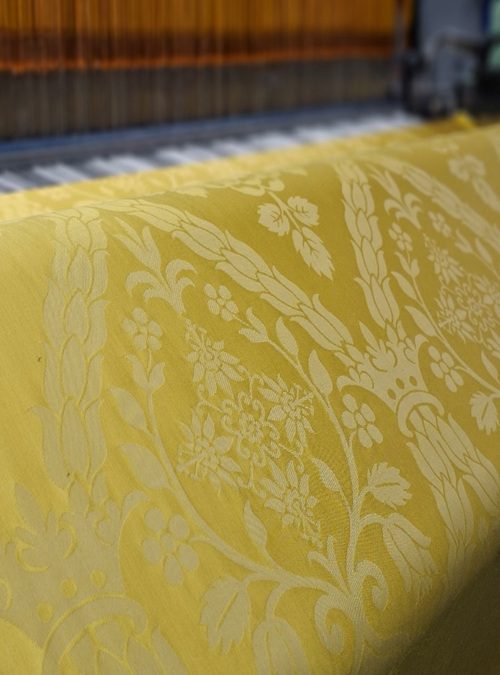
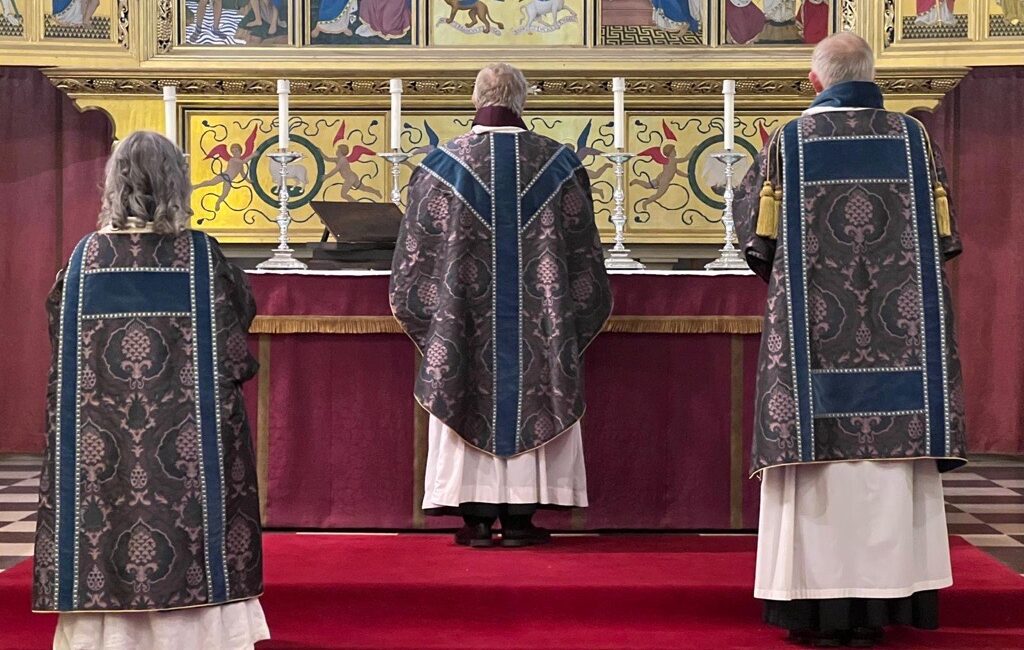
The Gothic style, whether in its original medieval form or later revivals, represents a remarkable synthesis of structural innovation, decorative richness, and symbolic meaning. For us at Humphries Weaving, working with Gothic inspired projects means engaging with centuries of design tradition, translating the soaring lines of pointed arches into textile patterns, and matching the jewel-toned richness of stained glass. Our archive contains numerous designs that echo Gothic motifs: heraldic patterns, architectural tracery translated into damask, and the rich colour palettes of medieval textiles.
If you have a love for gothic or gothic revivial style, would like to get in touch with the Humphries Weaving team to create your own design or to use our archive. Get intouch with us at fabric@humphriesweaving.co.uk
